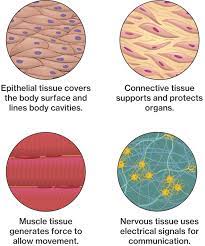Cells are like living bricks. They come in all different shapes and sizes, and they have different functions. But when cells work together, they can form tissues.
There are four main types of tissues: epithelial, connective, muscle, and nervous. Each type of tissue has different characteristics that make it suited for its specific function.
Epithelial tissue is made up of cells that are closely packed together. This type of tissue forms the outer layer of the skin and the lining of blood vessels and organs. Epithelial tissue is stronger and more durable than other tissues. Making it well suited for its job, which is to protect the other tissues from damage. Epithelial tissue can also secrete fluids like mucous, oil, and sweat.
Connective tissue is made up of cells that are spaced further apart. This type of tissue includes bone, cartilage, and blood. Connective tissue helps to hold the other tissues together. It helps to connect them.
Muscle tissue is made up of cells that can contract. This type of tissue is responsible for movement. This is the only type of tissue in the body that can move. Thus, anytime there is movement, it is the muscle tissue that is doing the work.
There are three types of muscle tissue. They are cardiac muscle which is found in the heart, smooth muscle which is found in the walls of hollow organs like the stomach, and skeletal muscle which is attached to bones.
Nervous tissue is made up of cells that can transmit electrical signals. This type of tissue forms the brain, spinal cord, and nerves. Nervous tissue is responsible for any thought, sensing, and transmission of messages. Nervous cells can actually generate electricity and then transmit it from cell to cell within the tissue.
Organs are made up of two or more types of tissues working together. For example, the stomach is an organ that is made up of all four types of tissue. The epithelial tissue forms the lining of the stomach, the connective tissue holds the organs together, the muscle tissue helps to mix and move the food, and the nervous tissue controls it all.
No matter what type of tissue it is, each cell in a tissue works together with all the other cells to perform its specific function. That’s what makes tissues so important!






